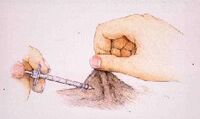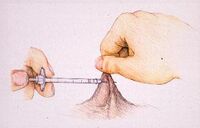Injecting insulin is done subcutaneously, under the skin, but not into muscle or vein. It's best to pull up some loose skin into a tent[1][2], then insert the needle firmly, bevel side up[3][4] for comfort[5].

Close-up illustration of a syringe needle showing bevel, point and heel.

Correct way to give an injection when "tenting" the skin. This makes sure the insulin is injected into the skin flap created by "tenting" it. When the skin "tent" is released, the injected insulin is under it, or subcutaneous.

Wrong way to give a shot: The needle has totally passed through the "tented skin". The insulin, or any other injected drug, will be injected into the air. Note that in this graphic, the injection point is much closer to the "pinch" area holding the "tent" up. In the correct graphic, the injection point is closer to the body.
BD has animations with narrations to help you learn how to draw insulin properly[6]. One can select from drawing one insulin or combining two insulins in the same syringe. Selecting this and the style of syringe you use personalizes the demo for your needs. The presentation is very clear and unhurried.
BD also has a slideshow which shows how to inject your dog[7] or cat[8].
Injecting cold from the refrigerator insulin[9] can sting, regardless of what species, type or brand. Bringing the insulin to room temperature by removing it from the fridge before actually using it can help avoid painful injections. Warming the capped insulin syringe with your hands can have the same effect. Some people tuck the capped and filled syringe under their arm for a few minutes to warm it before use. Do NOT attempt to warm insulin using a stove, microwave, etc.; you may destroy the insulin by doing so.
Do NOT wipe the needle with alcohol as it removes the protective coating which makes injection easier and less painful[10].
- Do not use the insulin if:
- Clear insulin that looks discolored or has turned cloudy.
There are sometimes leakage problems, when some insulin is lost when the needle is removed from the skin[16]. Some possible reasons and "fixes" for this are holding the "pinch" or "squeeze" too long which you made to give the shot. The skin, now with insulin under it, is still being "squeezed" as it was before the insulin went under the skin. The "pinch" forces some of the insulin back out from the newly-created hole in the skin. Releasing the "squeeze" or "pinch" first, then counting to 10 before removing the needle from the skin may give the insulin time to penetrate the fat layer and prevent leakage. Short needles can also cause insulin leakage--switching to longer ones can also help.
Injecting any insulin at the same site repeatedly over time or blunting a needle with re-use[17] can cause a lipodystrophy: either lipoatrophy or lipohypertrophy. Either makes absorption unreliable. But varying the injection site can cause variability in action profile, too. This page illustrates[18] illustrates the most common areas humans with diabetes inject insulin and explains how absorption differs in various areas of the human body. This is true for ALL insulins. The new shot area needn't be very far from where the last shot was given--the distance of the width of 2 fingers will do fine as a measure[19]. Most of us dealing with pet diabetes vary the side we give the injections in--right side mornings and left side evenings, for example. This is another help in avoiding giving shots in the same areas[20].
Many people give insulin shots in the scruff of the pet's neck, which is now considered to be a less than optimum choice. The neck area provides poor insulin Absorption, due to it not having many capillaries, veins. etc. (vascularization). Other sites suggested by Dr. Greco include the flank and armpit[21]. Intervet recommends giving injections from just back of the shoulder blades to just in front of the hipbone on either side, from 1 to 2 inches from the middle of the back[22].
See also diluting and combining insulin, rolling insulin, syringes and insulin pens.
Further Reading
- Washington State University-Diabetes Mellitus
Good general information with photos and tips about drawing insulin.
Pictorials
- Sugarpet Tatty being injected,
- Bob injecting his cat Stranger
- Steve injecting his cat Jock.
- BD Pictorial for cats Insulin Injections Slideshow
- Another one for Cats
- Cornell University Feline Health Center-Giving Insulin Injections Flash Movie
This contains good general information about drawing insulin and how to give insulin injections--not strictly for cats.
Online videos
Injection Site Rotation
Injection Time Tips
References
- ↑ Tenting as shown with Simon
- ↑ Tenting shown on a hairless cat for clarity
- ↑ Clinical Skills Assessments, Univ. of Illinois at Chicago (pdf)
- ↑ FDMB discussion on injection technique
- ↑ Cornell University Feline Health Center:How to Give an Insulin Injection Flash Movie
- ↑ BD Diabetes-Drawing Insulin Animation with Narration
- ↑ BD Diabetes Slideshow-Injecting a Dog
- ↑ BD Diabetes Slideshow-Injecting a Cat
- ↑ Injecting Cold Insulin
- ↑ PetDiabetes.org-Tips for Comfortable Injections
- ↑ Flocculation & Loss of Potency of Human NPH Insulin-Diabetes /Care-ADA-1988
- ↑ Flocculation of NPH Insulin-Revista Clinica Espanola-(English Translation)-1994
- ↑ Frosting Caused in NPH/Isophane Insulin By Heat/Cold-Journal-Diabetes.org-1998
- ↑ Dorlands Medical Dictionary-Definition of Flocculation
- ↑ Injection Insulin-Transcript of American Diabetes Association Videotape-2003
- ↑ Insulin Leaking From Injection Site
- ↑ Insulin-Dependent Diabetes-Dr. Ragnar Hanas-Page 21
- ↑ Common Human Insulin Injection Areas & Their Absorption Rates
- ↑ Joslyn Diabetes Center-Tips for Injecting Insulin
- ↑ BD Diabetes-FAQ's About Diabetic Dogs-Dr. Greco
- ↑ Better Medicine E-Newsletter-June 2006
- ↑ Vetsulin-Preparing Insulin & Giving Injection-Page 2

